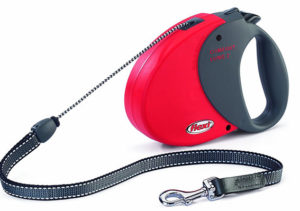Using body harnesses and head halters for better leash control

You may want to consider having your puppy use a body harness instead of a collar, especially for smaller-sized dogs. Body harnesses are secured with adjustable straps that fasten across the puppy’s chest and over its front legs.
There are various styles of body harnesses is to choose from, but the majority of them have the basic metal D-ring which clips to the leash and is located on the strap that runs down the dog’s back. They can be used instead of collars which provide a much safer environment when the puppy tries to pull away.
In this regard, the puppy receives the tension from the leash, instead of his or her neck, which could result in a spinal injury. Puppies are specially prone to running and darting every chance they get, even when on-leash. By removing the pressure from the dog’s airway, body harnesses are a safe and effective alternative to standard neck collars.
Other types of body harnesses
There is also a wonderful body harness that is specifically designed to discourage your dog or puppy from pulling away. It is manufactured so that the cords of the harness go down and under the front legs, then routing backup to where the lead attaches. When the dog attempts to pull, the cords automatically press on his armpit region, thereby stopping the dog in his attempt to pull away.
Another type of body harness designed to deter your puppy from going in his own direction is known as a “no pull” harness. This type of setup as a rain located in the center of the chest strap with a leash is attached. It is a simple these on that allows the leash to turn the dog’s body away from the direction he is trying to go into. If he tries to pull one way, the dog’s body will inadvertently be shifted into the opposite direction.
Are head halters considered a safe alternative?

Many dog owners prefer the use of head halters as an alternative to a body harness. There are several types of head halters available and all of them are designed to prevent your dog from pulling the leash.
Regardless of the specific type, all head halters have a strap that goes around your dog’s muzzle and then another strap that is securely placed around the neck. If the dog pulls away, the halter will force his head towards the opposite direction in which he is trying to move into.
Head halters work just fine but there are some drawbacks. For one thing, and halters look very similar to muzzles, and when strangers see a dog with a muzzle, it is assumed to be unfriendly. Some people may get nervous or give harsh stares toward your dog, others may react in a rude manner.
Another drawback is that most dogs do not get used to a head halter quickly. It takes quite some time for them to adjust to the strange fitting. It may take up to two to three weeks in some cases. If your dog reacts extremely negative towards the head halter, he may start to associate walks on the leash with an unpleasant experience. And let’s face it, walking outside with you should be your dog’s favorite pastime, so take notice of your pet’s reaction and try not to force a head halter on your dog if it does not appear to be working out.

